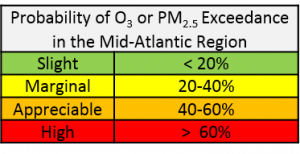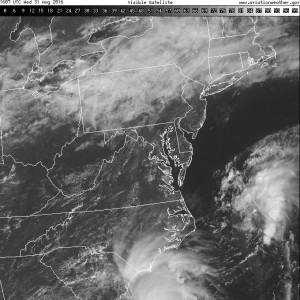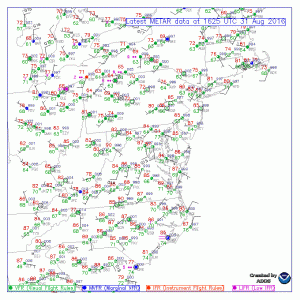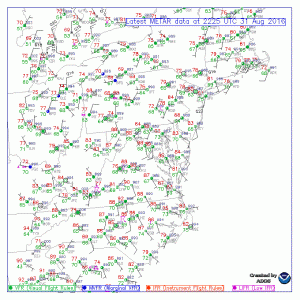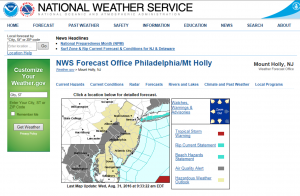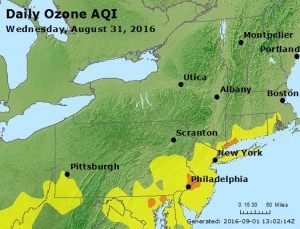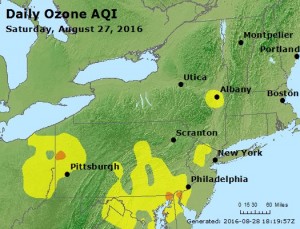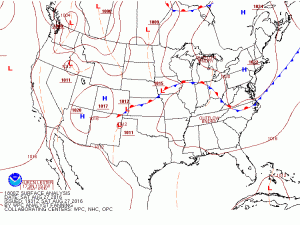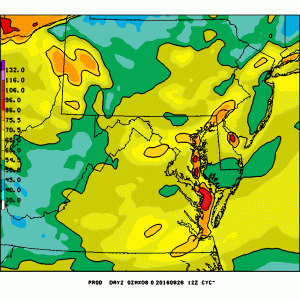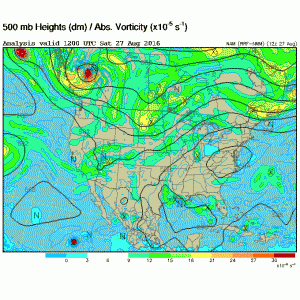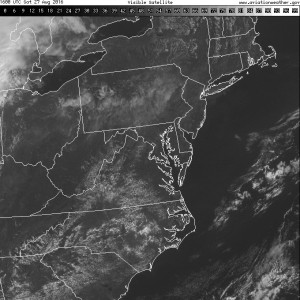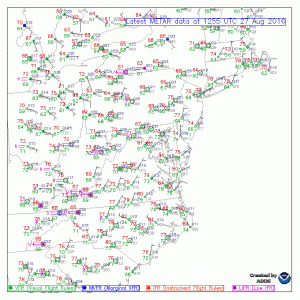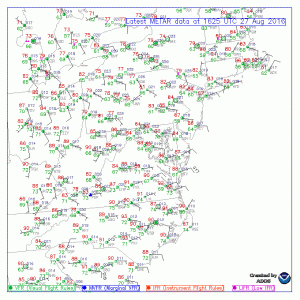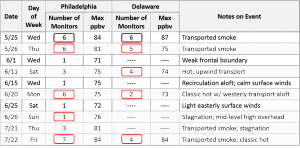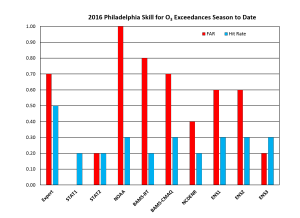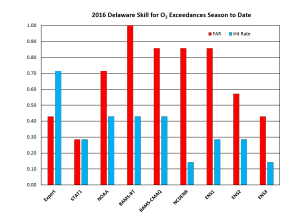Medium Range Air Quality Outlook
Mid-Atlantic Region
Issued: Monday, May 22, 2017
Valid: May 23-27, 2017 (Tuesday-Saturday)
Summary:
It will be a quiet week for air quality across the Mid-Atlantic region courtesy of a strong, winter-like upper level low that will dominate the weather for most of the medium range period. Good air quality will be the rule, with a chance for isolated low Moderate ozone on Wednesday (Northern Mid-Atlantic) and on Friday/Saturday (Southern Mid-Atlantic). The weather will be unsettled, with clouds and rain possible every day through Friday. The upper level low will expand eastward on Tuesday and Wednesday and then elongate over east coast on Thursday. This feature will allow a strong low to form at the surface on Wednesday, which will pull a slow-moving cold front through the Mid-Atlantic late Wednesday through Thursday evening. By Friday, the upper level trough will have contracted into New England, allowing a Southeastern ridge to push northward. This in turn will allow skies to clear and temperatures to rebound to around or slightly above average for the first part of the holiday weekend.
-Enlow/Huff
Discussion:
For the medium range forecast, models are in close agreement with the major features but have some disagreements with placement later in the forecast period. Models that were analyzed for this forecast were the 06Z GFS and NAM and the 00Z ECMWF. The period begins with a strong upper level trough across most of the CONUS, with a closed low at the center of its circulation, centered over the western Great Lakes/southern ON. On Tuesday, the closed low’s vorticity will split into two lobes, with one lobe moving way to join a trough in east/central Canada, while the other lobe sinks southward and reinforces the Eastern U.S. upper level trough. The trough will strengthen on Wednesday and move south- and eastward. At the same time, a new upper level closed low will move into the Pacific Northwest/southern Canadian Prairies. A weak ridge will form between these two upper level lows on Thursday. There are some minor discrepancies between the GFS and EC versus the NAM on Wednesday and Thursday regarding the strength and shape of the eastern trough, but overall pattern is similar. We focus on the EC and GFS, which have a broad closed low stretching over the entire eastern U.S. on Thursday – more of a winter-like than summer-like pattern. By Friday, the trough quickly contracts, with the main circulation moving northeastward into New England and the weak ridge progressing into Great Lakes region before reaching the Mid-Atlantic on Sunday.
The slow-moving cold front will reach the I-95 Corridor early Tuesday morning, bringing precipitation that could linger throughout the day. The front will clear the Northern Mid-Atlantic (NMA) but stall across the Southern Mid-Atlantic (SMA). There is some model disagreement as to exactly where and when precipitation associated with the front will occur, but it is most likely across the SMA, following the track of the front. Regardless, it will be a mostly cloudy and unsettled day across the region. Pollutant concentrations are currently low, and there is clean air behind the cold front. Therefore, Good air quality is expected.
The big story on Wednesday is the strong low forming over the central Mississippi River Valley. This low will strengthen quickly and gradually progress northeastward, pulling along a cold front that will bring clouds and periods of heavy rain to the western and southern portions of the region. Skies should remain clear along the northern I-95 Corridor, however, which will allow temperatures to briefly rebound to around average. The 06Z air quality models respond to this clearing and develop an area of Moderate ozone along the Mason-Dixon Line (MDL) and northern extent of I-95. This seems a bit overdone, given the likely very clean air mass in place, but certainly scattered Moderate ozone is possible. Elsewhere, the clouds and rain will limit ozone and particles to the Good range.
The slow-moving cold front will continue its progression through the Mid-Atlantic on Thursday. The system will bring periods of heavy rain to the region. Precipitation is most likely during the morning and afternoon, with rain tapering off in the evening as the low pulls away toward the Northeast. This system will ensure another day of Good air quality.
Skies will clear on Friday as the low moves into New England. The Southeastern ridge will begin to push into the SMA, with clearing occurring from south to north across the region. Temperatures will begin to rise as a result, but only up to around normal for this time of year. Continued Good air quality is anticipated, with the cleanest conditions across the NMA, where the influence of the retreating low will be felt the longest.
On Saturday, the trend is for the Southeastern ridge to continue progressing northward, bringing mostly sunny skies to the entire region. The GFS is a bit stronger with the ridge, but both it and the EC show a similar placement, with the northern extent of the ridge only reaching as far north as roughly the MDL. Temperatures will continue to moderate, but they will remain around or slightly above average. As a result, only scattered Moderate ozone is expected.
-Enlow/Huff


